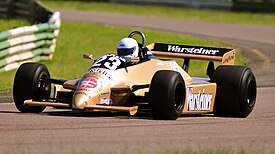
Riccardo Gabriele Patrese is an Italian former racing driver, who raced in Formula One from 1977 to 1993.

BMW has been involved in Formula One in a number of capacities since the inauguration of the World Drivers' Championship in 1950. The company entered occasional races in the 1950s and 1960s, before building the BMW M12/13 inline-four turbocharged engine in the 1980s. This engine was the result of a deal between BMW and Brabham, which resulted in the team's chassis being powered by BMW engines from 1982 until 1987, a period in which Nelson Piquet won the 1983 championship driving a Brabham BT52-BMW. BMW also supplied the M12/13 on a customer basis to the ATS, Arrows, Benetton and Ligier teams during this period, with various degrees of success. In 1988, Brabham temporarily withdrew from the sport and BMW withdrew its official backing from the engines, which were still used by the Arrows team under the Megatron badge. Turbocharged engines were banned by the revised Formula One Technical Regulations for 1989, rendering the M12/13 obsolete.
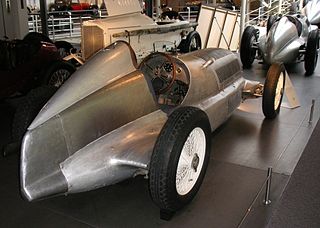
Silver Arrows is a nickname typically given to silver racing cars with a significant connection to a German car manufacturer. Although the term was coined in 1932, it came into popular usage regarding Germany's dominant Mercedes-Benz and Auto Union Grand Prix motor racing cars between 1934 and 1939. The name was later applied to the Mercedes-Benz Formula One and sports cars in 1954 and 1955, then to the Sauber Group C prototype racing sports cars that raced at Le Mans in the late 1980s as well as the McLaren-Mercedes Formula One cars of the late 1990s and 2000s, and is currently applied to the Mercedes-AMG Petronas F1 cars from 2010 to present.
Arrows Grand Prix International was a British Formula One team active from 1978 to 2002. It was known as Footwork from 1991 to 1996.

The 1980 Brazilian Grand Prix was a Formula One motor race held on 27 January 1980 at the Interlagos circuit in the Interlagos neighborhood of São Paulo. It was the second round of the 1980 Formula One season, and it was also the ninth Brazilian Grand Prix. It was the eighth to be held at Interlagos and would be the last until the circuit was substantially redeveloped for the 1990 Brazilian Grand Prix. The race was held over 40 laps of the 7.87-kilometre circuit for a total race distance of 315 kilometres. This race was originally supposed to be held at the Jacarepaguá circuit in Rio de Janeiro, but was transferred to Interlagos because parts of the Rio circuit's tarmac were actually sinking into the soft swampland the circuit was built on. This last-minute switch to Interlagos- which was to be resurfaced and heavily rebuilt with new pit facilities and safety measures for the 1981 season caused a lot of controversy- Interlagos had returned a bit too soon for some of the drivers- the facility had been barely and badly maintained over the years.

The 1980 Monaco Grand Prix was a Formula One motor race held at Monaco on 18 May 1980. It was the sixth round of the 1980 Formula One season. The race was the 38th Monaco Grand Prix. The race was held over 76 laps of the 3.34-kilometre circuit for a total race distance of 254 kilometres.
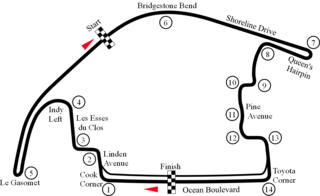
The 1981 United States Grand Prix West was a Formula One motor race held on March 15, 1981, at Long Beach, California. It was the opening race of the 1981 Formula One World Championship.

Life was a Formula One constructor from Modena, Italy. The company was named for its founder, Ernesto Vita. Life first emerged on the Formula One scene in 1990, trying to market their unconventional W12 3.5-litre engine.

Merzario was a Formula One and Formula Two team and constructor from Italy. The team participated in 38 Formula One World Championship Grands Prix but scored no championship points.
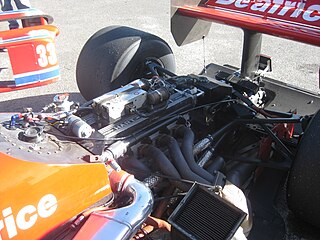
Brian Hart Ltd., also known as Hart and Hart Racing Engines, was a motor racing engine manufacturer that participated in 157 Formula One Grands Prix, powering a total of 368 entries.

Ronald Sidney Tauranac was a British-Australian engineer and racing car designer, who with Formula One driver Jack Brabham founded the Brabham constructor and racing team in 1962. Following Brabham's retirement as a driver at the end of the 1970 season, Tauranac owned and managed the Brabham team until 1972, when he sold it to Bernie Ecclestone. He remained in England to assist with a redesign of a Politoys Formula One chassis for Frank Williams in 1973 and helped Trojan develop a Formula One version of their Formula 5000 car.

The BMW M12/13 turbo was a 1,499.8 cc four-cylinder turbocharged Formula One engine, based on the standard BMW M10 engine introduced in 1961, and powered the F1 cars of Brabham, Arrows and Benetton. Nelson Piquet won the FIA Formula One Drivers' Championship in 1983 driving a Brabham powered by the BMW M12/13 turbo. It was the first Drivers' Championship to be won using a turbocharged engine. The engine also powered the BMW GTP and in the 2.0-litre naturally-aspirated form, the successful March Engineering Formula Two cars. BMW engineers estimated the engine produced around 1,400 hp at maximum boost, however the BMW engine dynamometer could not go beyond 1,280 bhp.

The Lotus 88 is an innovative Formula One car designed by Colin Chapman, Peter Wright, Tony Rudd and Martin Ogilvie of Lotus in an effort to maximise the downforce produced by ground effect. The Lotus 88 made its debut at the first practice session of the 1981 season opener, the US Grand Prix West at Long Beach. Although the Lotus 88 was not allowed to race, it was the first Formula One car to use a carbon fibre monocoque chassis and debut at a Grand Prix event. The carbon fibre McLaren MP4 made its first appearance at the third Grand Prix of the season in Argentina.

The Brabham BT49 is a Formula One racing car designed by South African Gordon Murray for the British Brabham team. The BT49 competed in the 1979 to 1982 Formula One World Championships and was used by Brazilian driver Nelson Piquet to win his first World Championship in 1981.

Footwork Arrows was a British Formula One motor racing team which competed from 1991 to 1996. Japanese businessman Wataru Ohashi, who was the president of Footwork Express Co., Ltd., a Japanese logistics company, began investing heavily in the Arrows team in 1990, the deal including requiring the cars to display the Footwork logo prominently. The team was officially renamed Footwork in 1991, and secured a deal to race with Porsche engines. Results were poorer than expected, and after just six races, Footwork dropped the Porsche engines and continued with Hart-built Ford engines.

The Arrows A6 was a Formula One car which the Arrows team used to compete in the 1983 and 1984 Formula One seasons. It was designed by Dave Wass and powered by the Cosworth DFY V8 engine. The A6 used a honeycomb monocoque frame, as a carbon fibre chassis was too expensive.

The Arrows A2 was a Formula One racing car, designed by Tony Southgate and Dave Wass, was used by the Arrows team in the latter half of the 1979 Formula One season. Powered by a Cosworth DFV V8 engine and driven by Riccardo Patrese and Jochen Mass, it was relatively unsuccessful with its best finish being sixth on two occasions.

The Arrows A5 was the car which the Arrows Formula One team used to compete in the 1982 Formula One season. The A5 appeared late in the season, and was primarily a development car, with the lessons learned to be applied to the A6 for the upcoming 1983 Formula One season.

The Brabham BT56 was a Formula One car designed by John Baldwin and Sergio Rinland and raced by the Brabham team in the 1987 Formula One World Championship. It was driven by Andrea de Cesaris, Riccardo Patrese and Stefano Modena; both de Cesaris and Patrese scored a 3rd place driving the BT56.
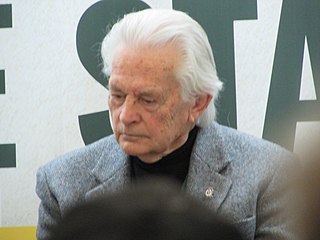
Tony Southgate is an English engineer and former racing car designer. He designed many successful cars, including Jaguar's Le Mans-winning XJR-9, and cars for almost every type of circuit racing. He was responsible for the chassis design of Ford's RS200 Group B rally car. Southgate was employed as chief designer or technical director for many Formula One teams for over twenty years. These teams included BRM, Shadow and Arrows. Southgate retired after producing the Audi R8C, which was a major influence in the Bentley Speed 8, which won Le Mans in 2003. He continues to be a regular visitor to current and historic race meetings.
